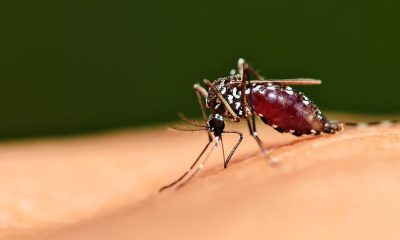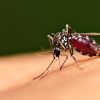Health
Ugandan scientists start developing aflatoxin-resistant ground nuts
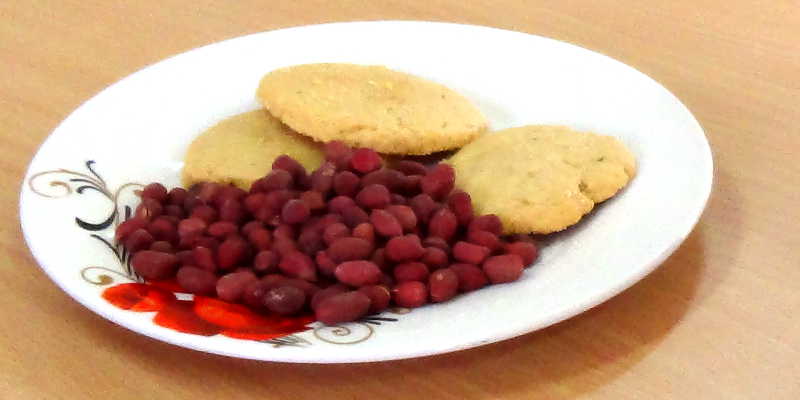
Roasted ground nuts are a popular snack in Uganda
It is a busy afternoon at St. Balikuddembe market in down town Kampala. Karimojong girls are working like termites under a temporary shade to remove foreign matter such as stones from broken ground-nuts before their boss hands the stuff over for milling in a locally fabricated machine to produce a paste.
People familiar with this business however reveal that makers of ground-nut paste prefer to mill the broken or ‘wounded’ ground nuts as a way of disguising them for good products instead of throwing them away.
But as research has shown, broken or ‘wounded’ grain tends to invite fungi that produce toxic substances technically known as aflatoxins, a problem that is attracting growing global attention for its proven devastating effects on the health of human beings as well as livestock.
The International Agency for Research on Cancer (IARC), arguably the world’s number one authority on the disease, lists aflatoxins as a class one carcinogen – meaning that eating food contaminated with aflatoxins presents a very high risk of getting cancer of the liver.
The WHO and other scientists have warned that repeated eating of food stuffs that are contaminated with aflatoxins, can cause cancer among humans. However, if eaten in very high doses, as was the case in eastern Kenya in 2004, the toxins can cause immediate death.
Now, researchers at the National Agricultural Research Laboratories (NARL) at Kawanda, have embarked on a study to try to counter the challenge of aflatoxins in ground-nuts using modern biotechnology tools that can kill the fungus when it gets into contact with the plant, grain or seed.
Dr. Andrew Kiggundu, a senior scientist with NARL says: “We are using a technique known as gene silencing to kill the fungus that produce aflatoxins, when they get into contact with the ground nut. Because a seed is a living organism, we hope that this protection will prevail from the point it’s planted through the entire value chain.”
Kiggundu adds that: “We have identified three essential genes in the fungus that are important for its survival. What we have done is like immunising the plant against the fungus. If the fungus gets into contact with G-nuts, it should be able to die.”
Kiggundu says that they have completed isolating the genes and are now set to transfer them into the G-nut plants such that they can grow with the genes of interest.
NARL is receiving support for the three year research experiment from the Bill and Melinda Gates Foundation as well as Venganza, a private biotechnology company based in the United States that has found niche in identifying essential genes, according to Kiggundu.
A delicacy and part of culture
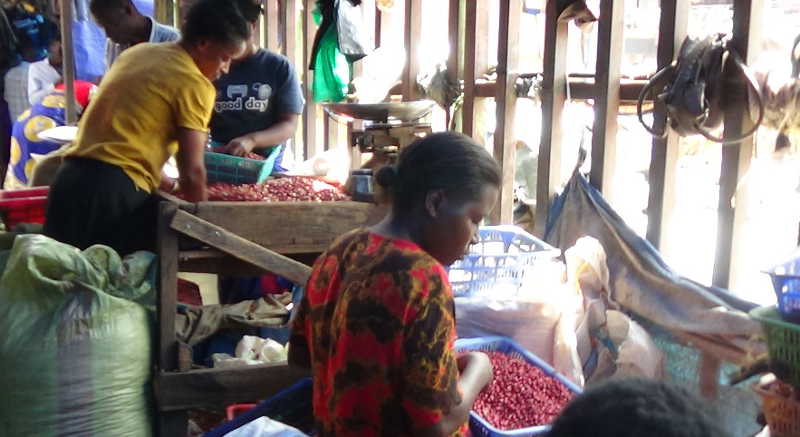
Ladies sorting ground-nuts in St. Balikuddembe market in Kampala. Researchers say that the vendors use lots of damaged or broken ground nuts, which increases chances of the presence of aflatoxin
Ground nuts are not only a delicacy in many Ugandan communities, it is a major staple food. Ground nut paste is eaten as source, while the grains are commonly roasted and eaten as a snack.
Some consumers are however more concerned about buying ground nut paste contaminated with steel particles that may come off the grinding machines. Few however know about an equally serious danger that arises from eating ground-nuts that are contaminated with aflatoxins.
According to Dr. Andrew Kiggundu, a senior researcher at the National Agricultural Research Laboratories (NARL), eating food that is contaminated with aflatoxins can cause immediate death – in case of severe acute exposure. And if eaten in smaller dozes but repeatedly, aflatoxins can cause cancer, adds Kiggundu.
“The trouble with aflatoxin is that they are highly heat stable. The toxins have shown that they retain their structure even with regular heating conditions,” says Kiggundu.
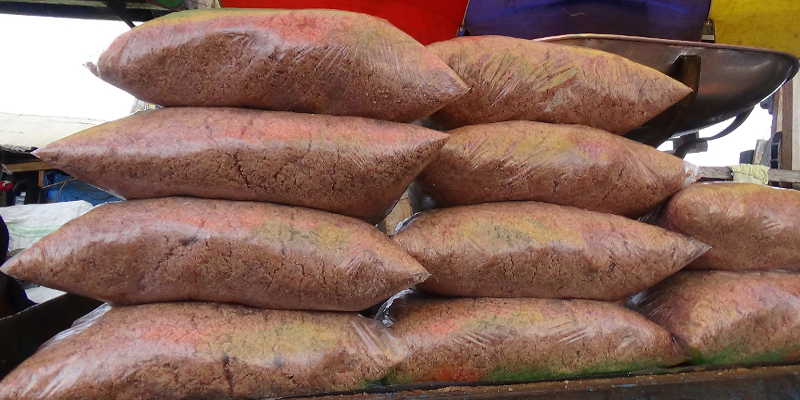
Milled ground-nut flour is ready for cooking into a paste or source. Ground nut paste is popular, but it’s often used as a method to disguise broken ground-nuts that may be contaminated with aflatoxins.
In 2004, more than 100 people in Eastern Kenya died only a few days after they ate maize that was found to be contaminated with aflatoxins.
The European Union, which is Uganda’s biggest export market, has strict regulations on food imports containing aflatoxins. The US National Cancer Institute also says that Exposure to aflatoxins is associated with an increased risk of liver cancer.
Scientists have shown that beyond causing liver cancer, aflatoxins can cause Jaundice, compromise the immune system in humans and animal as well as interfere with the absorption of essential nutrients such as proteins and micro nutrients like zinc, Vitamin A, which results into child stunting.
Different studies carried out by researchers including from Makerere University have found concentrations of aflatoxins in ground nuts and other cereals especially on the Ugandan market as well as at farmer level to be several times higher than the World Health Organisation’s recommended 20 parts per billion limit.
For example, two studies that were carried out by Rebecca Nakamya and colleagues on the presence of aflatoxins in imported as well as locally produced baby food, found high levels of aflatoxin concentration in all locally produced baby foods that were being sold in supermarkets in Kampala.
The studies carried out in 2012 and 2013, show that even some of the imported baby foods were contaminated but that local brands had levels ranging between 20-50ppb.
More worrying perhaps, according to a 1999 study by Archileo Kaaya, a Makerere University researcher from the Faculty of Food Science and Technology, is that products that had maize, soybean and fish, which are the most used ingredients in Uganda and are preferred by most parents for their high protein content, have turned out disappointing results with high levels of contamination.
If the current experiment proves successful, curing other plants such as maize which also face a serious problem of aflatoxin contamination will likely be given a great boost. Currently, there is considerable work on maize using modern genetic engineering science such as the successful trail on integration of technology that kills the maize stalk borer.
Scientists from Uganda and Kenya have developed alternative measures to try to address the problem of aflatoxins, but they both seem laborious, out of reach for many smallholder poor farmers and may not address the whole value chain of ground-nuts from planting through to the final consumer product.
In 2013, Dr. Charity Mutegi, Kenyan researcher won the prestigious Norman Borlaug Field Award for inventing a product known as Aflasafe that combats aflatoxins in grain. According to Kiggundu, Mutegi’s product works like a vaccine so that when sprayed on the maize, or contaminated cereals, it out-competes the dangerous Aspergillus flavus strain type that produce aflatoxins.
In Uganda, researchers at the Uganda Industrial Research Institute (UIRI) have also developed a machine that can easily and quickly test for the presence of aflatoxins in grain. And while the innovation awaits to be produced for commercial use, concerns remain about the high cost of testing for aflatoxin in Uganda.
Uganda’s effort to combat the problem comes as a timely intervention for the population that is facing the adverse effects of increased frequency of extreme drought and wet conditions, rising cases of cancer that could be associated with aflatoxins as well as persistently high cases of child stunting.
A 2007 study by the International Journal of Food Microbiology, in the United States, also showed evidence of increased levels of aflatoxin contamination during periods of extreme weather conditions in the United States.
Indeed, as the 2015 prolonged first rain season in Uganda proved, poor farmers trying to make ends meet were forced to shell half-dried cereals to prevent total loss as the rains hit the fields endlessly.
While still in its infancy, the research study has already attracted optimism from farmers as well as traders. Charles Bukenya, a trader who exports grain to Kenya, expressed hope that the technology will open the doors to his business especially in the regional Common Market for Eastern and Southern Africa (COMESA) which has proposed to enforce safety measures for goods traded in the region.
The Ugandan parliament is yet to pass into law a bill that would allow for commercialization of products of biotechnology such as the anticipated aflatoxin-resistant ground-nuts.
Until such a law is passed, several successful studies conducted by Ugandan researchers on controlling diseases in bananas, maize, cassava and Irish potatoes will remain out of reach by farmers who will probably need them to stem losses and improve food security and incomes.
The ground-nut study, if successful, will also further cement the argument by supporters of biotechnology in Uganda that the science seeks to benefit smallholder Ugandan farmers and not multinational companies since seed for these products is largely shared by community members.
Comments











